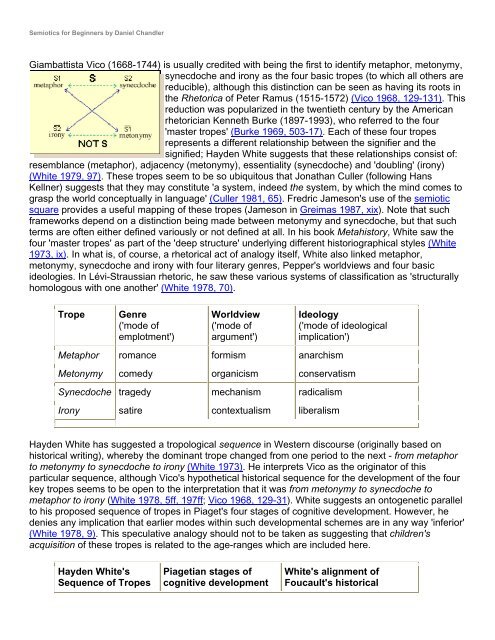Semiotics for Beginners by Daniel Chandler
Semiotics for Beginners by Daniel Chandler
Semiotics for Beginners by Daniel Chandler
Create successful ePaper yourself
Turn your PDF publications into a flip-book with our unique Google optimized e-Paper software.
<strong>Semiotics</strong> <strong>for</strong> <strong>Beginners</strong> <strong>by</strong> <strong>Daniel</strong> <strong>Chandler</strong><br />
Giambattista Vico (1668-1744) is usually credited with being the first to identify metaphor, metonymy,<br />
synecdoche and irony as the four basic tropes (to which all others are<br />
reducible), although this distinction can be seen as having its roots in<br />
the Rhetorica of Peter Ramus (1515-1572) (Vico 1968, 129-131). This<br />
reduction was popularized in the twentieth century <strong>by</strong> the American<br />
rhetorician Kenneth Burke (1897-1993), who referred to the four<br />
'master tropes' (Burke 1969, 503-17). Each of these four tropes<br />
represents a different relationship between the signifier and the<br />
signified; Hayden White suggests that these relationships consist of:<br />
resemblance (metaphor), adjacency (metonymy), essentiality (synecdoche) and 'doubling' (irony)<br />
(White 1979, 97). These tropes seem to be so ubiquitous that Jonathan Culler (following Hans<br />
Kellner) suggests that they may constitute 'a system, indeed the system, <strong>by</strong> which the mind comes to<br />
grasp the world conceptually in language' (Culler 1981, 65). Fredric Jameson's use of the semiotic<br />
square provides a useful mapping of these tropes (Jameson in Greimas 1987, xix). Note that such<br />
frameworks depend on a distinction being made between metonymy and synecdoche, but that such<br />
terms are often either defined variously or not defined at all. In his book Metahistory, White saw the<br />
four 'master tropes' as part of the 'deep structure' underlying different historiographical styles (White<br />
1973, ix). In what is, of course, a rhetorical act of analogy itself, White also linked metaphor,<br />
metonymy, synecdoche and irony with four literary genres, Pepper's worldviews and four basic<br />
ideologies. In Lévi-Straussian rhetoric, he saw these various systems of classification as 'structurally<br />
homologous with one another' (White 1978, 70).<br />
Trope Genre<br />
('mode of<br />
emplotment')<br />
Worldview<br />
('mode of<br />
argument')<br />
Ideology<br />
('mode of ideological<br />
implication')<br />
Metaphor romance <strong>for</strong>mism anarchism<br />
Metonymy comedy organicism conservatism<br />
Synecdoche tragedy mechanism radicalism<br />
Irony satire contextualism liberalism<br />
Hayden White has suggested a tropological sequence in Western discourse (originally based on<br />
historical writing), where<strong>by</strong> the dominant trope changed from one period to the next - from metaphor<br />
to metonymy to synecdoche to irony (White 1973). He interprets Vico as the originator of this<br />
particular sequence, although Vico's hypothetical historical sequence <strong>for</strong> the development of the four<br />
key tropes seems to be open to the interpretation that it was from metonymy to synecdoche to<br />
metaphor to irony (White 1978, 5ff, 197ff; Vico 1968, 129-31). White suggests an ontogenetic parallel<br />
to his proposed sequence of tropes in Piaget's four stages of cognitive development. However, he<br />
denies any implication that earlier modes within such developmental schemes are in any way 'inferior'<br />
(White 1978, 9). This speculative analogy should not to be taken as suggesting that children's<br />
acquisition of these tropes is related to the age-ranges which are included here.<br />
Hayden White's<br />
Sequence of Tropes<br />
Piagetian stages of<br />
cognitive development<br />
White's alignment of<br />
Foucault's historical




